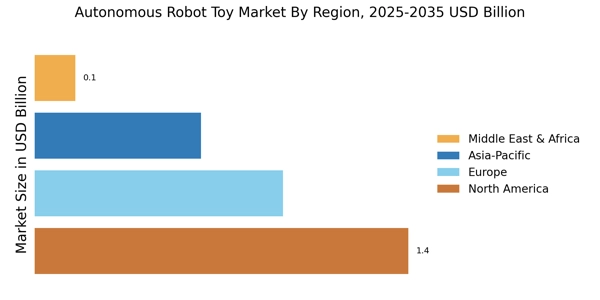Expansion of E-commerce Platforms
The rise of e-commerce platforms has transformed the way consumers access products, including those in the Autonomous Robot Toy Market. Online shopping provides convenience and a wider selection of products, allowing consumers to compare prices and features easily. This shift has led to increased sales of autonomous robot toys, as parents can readily find and purchase these innovative products from the comfort of their homes. Data indicates that e-commerce sales in the toy industry have grown significantly, with projections suggesting that online sales could account for over 30% of total toy sales in the near future, further driving the growth of the Autonomous Robot Toy Market.
Growing Interest in STEM Education
The Autonomous Robot Toy Market is significantly influenced by the increasing emphasis on STEM (Science, Technology, Engineering, and Mathematics) education. Parents and educators recognize the value of introducing children to these subjects at an early age. Autonomous robot toys often serve as educational tools that promote problem-solving skills and critical thinking. This trend aligns with the broader educational landscape, where there is a push for innovative teaching methods. Market data suggests that the demand for educational toys, particularly those that incorporate robotics, is expected to rise, potentially leading to a market expansion worth billions in the next few years.
Rising Demand for Interactive Play
The Autonomous Robot Toy Market experiences a notable increase in demand for interactive play experiences among children. Parents are increasingly seeking toys that not only entertain but also engage their children in meaningful ways. This trend is driven by a growing awareness of the importance of cognitive development during early childhood. According to recent data, the market for interactive toys is projected to grow at a compound annual growth rate of approximately 15% over the next five years. This shift towards interactive play is likely to propel the Autonomous Robot Toy Market, as these toys often incorporate advanced technologies that facilitate interaction and learning.
Technological Advancements in Robotics
Technological advancements play a crucial role in shaping the Autonomous Robot Toy Market. Innovations in robotics, such as improved sensors, artificial intelligence, and machine learning, enhance the capabilities of autonomous toys. These advancements allow for more sophisticated interactions and functionalities, making toys more appealing to both children and parents. The integration of AI enables toys to adapt to individual play styles, fostering a personalized experience. As a result, the market is witnessing a surge in the development of high-tech autonomous toys, which are expected to capture a larger share of the market, potentially reaching a valuation of several billion dollars in the coming years.
Increased Focus on Child Safety Standards
The Autonomous Robot Toy Market is also shaped by a heightened focus on child safety standards. As parents become more aware of safety concerns related to toys, manufacturers are compelled to adhere to stringent regulations and guidelines. This focus on safety not only builds consumer trust but also enhances the overall quality of products in the market. Compliance with safety standards can serve as a competitive advantage for companies, potentially leading to increased market share. As the industry evolves, the emphasis on safety is likely to remain a key driver, influencing purchasing decisions and shaping the future landscape of the Autonomous Robot Toy Market.

















Leave a Comment